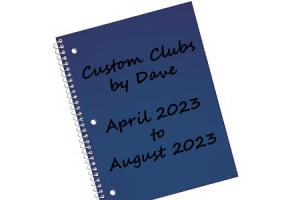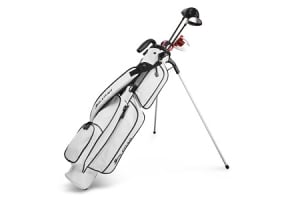
At the beginning of the golf season or if you recently purchased new irons and have been able to go out to the range and get a few rounds under your belt, it might be wise to have your iron distance gaps checked. Why? By gapping your entire set of clubs or at least your irons and wedges correctly, it can help you score better by not having two clubs with overlapping distances or in other cases creating large gaps between two adjacent clubs in your set.
What is distance gapping?
It is the process of evaluating your clubs and making sure you are spreading out the distance gaps better between consecutive clubs. The advent of portable launch monitors, golf trackers (like Arccos or GPS devices), and rangefinders has made this process more accessible to the everyday golfer. Checking your distance gapping is very simple. Take 5 to 10 shots with each club and get an average of how far you carry the ball. If you flub one or two of them, don’t count them in your averages. After all, 99% of golfers won’t be as consistent as a pro.
A quick note about the distance gapping of wedges. Oftentimes you do not hit full shots with these clubs. You can dial in the distance by practicing ¾ and ½ shots too and know the distances you hit them. This gives you multiple options for the same distance, but different trajectories.
What Causes Golf Club Gapping Irregularities?
There are mitigating factors that create irregular distance gaps. One reason is manufacturing tolerances, and another is normal wear and tear. Over time hitting tree roots or pounding the ground with irons made from soft material (such as forgings) could make the loft (and lie) go out of whack. The last reason is a golfer may decide to mix and match different clubs in their set, especially wedges that are not part of their iron set.
Manufacturing Tolerances
To make golf clubs affordable, there are certain manufacturing tolerance that are commonplace. Typically for loft (and lie) an acceptable tolerance is +/- 1°. Therefore, it could be possible that a set might have some irons with as little as 1° difference in loft and 5 or 6° between others. This chart shows an ordinary set, yet each of the irons is again well within the tolerance range.
|
Iron |
Loft (spec) |
Loft (actual) |
|
# |
degrees |
degrees |
|
4i |
23 |
22 |
|
5i |
26 |
27 |
|
6i |
29 |
29 |
|
7i |
33 |
34 |
|
8i |
37 |
36 |
|
9i |
41 |
42 |
|
PW |
45 |
44 |
|
GW |
52 |
52 |
|
SW |
56 |
55 |
What is the proper distance gapping for golf clubs?
First, it will be different for each golfer depending upon their swing speed. Tour players might see 13 to 15-yard gaps between each club or iron. For an average strength male golfer, the iron distance gaps may be closer to 10 yards between consecutive clubs. For slower swinging women golfers, they may experience closer to 6-yard gaps questioning whether they need the full complement of 14 clubs in the bag.
Determining How to Adjust Your Irons and Wedges
By going to a club maker and checking the lofts bending appropriately can these possible situations be resolved. I would also encourage you to have the lie checked at the same time. A good gapping analysis is done by examining the average distance gaps between clubs and looking at the actual lofts of the clubs.
|
Iron |
Loft (spec) |
Loft (actual) |
Average Carry Distance |
Suggestion |
|
# |
degrees |
degrees |
yards |
|
|
4i |
23 |
22 |
175 |
consider 4-hybrid |
|
5i |
26 |
27 |
171 |
bend 1° stronger |
|
6i |
29 |
29 |
165 |
none |
|
7i |
33 |
34 |
152 |
bend 1° stronger |
|
8i |
37 |
36 |
146 |
none |
|
9i |
41 |
42 |
131 |
bend 1° stronger |
|
PW |
45 |
44 |
127 |
bend 1° weaker |
|
GW |
52 |
52 |
102 |
bend 2° stronger |
|
SW |
56 |
55 |
95 |
none |
In this case, the 4-iron was already stronger lofted, yet the distance was nearly identical to the 5-iron. It would be recommended to replace the 4-iron with a more forgiving 4-hybrid to help increase the gap to the other clubs in the set.
Basic pricing for bending the loft of an iron or wedge is $4.50 - $5.00 per club and well worth it. This is assuming of course the irons and wedges are malleable enough to alter. Certain materials and heat treatments make bending some models virtually impossible. Drivers, fairway woods, and hybrids aren’t bendable. However, some models may have adjustable shaft sleeves where it could change the effective loft by rotating the shaft sleeve in a different position.
If you are looking to hit your irons longer, here is a word of caution. A clubmaker could effectively reduce the loft of most irons on the market by a couple of degrees with a lie/loft machine. This will provide little in the way of “extra distance”. For instance, if a player is hitting their irons with a 10-yard gap between each iron, then bending all the lofts stronger by 2° is only going to provide that player with at most 5 additional yards. After all, the gap in loft from one iron to the next is generally 3-5 degrees.
Gapping your irons and wedges properly will provide peace of mind knowing that your carry distances will provide the perfect gap between your clubs and one less thing to worry about on the golf course.





